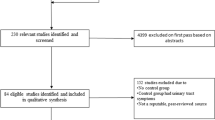Abstract
Forth-five premenopausal women were enrolled in the study. All patients underwent a complete diagnostic evaluation, which included the completion of a standardized questionnarie, a detailed history, a complete physical examination and multichannel urodynamic testing. Clinical findings and urodynamic parameters were recorded. Logistic regression analysis and χ2 comparisons were used to determine which factor(s) were most associated with the presence of genuine stress incontinence. Thirty patients had genuine stress incontinence, and 15 asymptomatic volunteers without subjective and objective lower urinary tract dysfunction served as controls. A significant difference in age, maximum urethral closure pressure, strength of cough and bladder-neck mobility was found between the two groups. Logistic regression analysis revealed that bladder-neck mobility was the variable most associated with the presence of genuine stress urinary incontinence. This study supports the concept the genuine stress incontinence is probably multifactorial, and its etiology remains unknown.
Similar content being viewed by others
References
Lapides J, Ajemian EP, Steward BH et al. Physiopathology of stress incontinence.Surg Gynecol Obstet 1960;3:224–231.
Bhatia NN, Ostergard DR. Urodynamics in women with stress urinary incontinence.Obstet Gynecol 1982;60:552–559
Richardson DA. Value of the cough pressure profile in the evaluation of patients with stress incontinence.Am J Obstet Gynecol 1986;155:808–811
Bump RC, Fantl JA, Hurt WG. Dynamic urethral pressure profilometry pressure transmission ratio determinations after incontinence surgery: understanding the mechanism of success, failure, and complications.Obstet Gynecol 1988;72:870–874
Hilton P, Stanton SL. Urethral pressure measurement by microtransducer: the results in symptom-free women and in those with genuine stress incontinence.Br J Obstet Gynecol 1983;90:919–933
Karram MM, Bhatia NN. The Q-tip test: standardization of the technique and its interpretation in women with urinary incontinence.Obstet Gynecol 1988;71:807–811
Karram MM. Urodynamics: cystometry. In: Walters MD, Karram MM, eds. Clinical urogynecology. St. Louis: Mosby-Year Book Inc. 1993:62–76
Bump RC, Copeland WE, Hurt WG, Fantl JA. Dynamic, urethral pressure/profilometry pressure transmission ratio determination in stress incontinent and stress continent subjects.Am J Obstet Gynecol 1988;159:749–755
Abrams P, Blaivas JG, Stanton SL, Anderson JT. The standardization of terminology of lower urinary tract function recommended by the International Continence Society.Int Urogynecol J 1990;1:45–58
Rozenzweig BA, Bhatia NN, Nelson AL. Dynamic urethral pressure profilometry pressure transmission ratio: What do the numbers really mean?Obstet Gynecol 1991;77:586–589
Vesi E, Cardozo L, Cooper DJ. Urethral pressures: analysis of transmission pressure ratios.Br J Urol 1991;68:266–290
Richardson DA. Reduction of urethral pressure in response to stress: relationship of urethral mobility.Am J Obstet Gynecol 1986;155:20–25
Author information
Authors and Affiliations
Additional information
Editorial Comment: This is one of the few studies that has attempted to correlate possible etiologic factors for genuine stress incontinence in both symptomatic subjects as well as asymptomatic controls. The factor found to be most associated with stress incontinence was the mobility of the urethrovesical junction, as measured by the angle of the Q-tip from the horizontal, when compared to the controls. We should not be misled by this, however, since hypermobility is so common that many patients have this anatomical abnormality without ever having stress incontinence. The diagnosis of stress incontinence cannot therefore be made by the simple presence of urethral hypermobility. The authors correctly conclude that the etiologic factors in stress incontinence are multifactorial, and the collage of information presented by the patient in both clinical and urodynamic terms must be considered in the determination of the ultimate diagnosis.
Rights and permissions
About this article
Cite this article
Karram, M.M., Partoll, L. & Hoopes, T. Factors associated with the presence of genuine stress incontinence in females. Int Urogynecol J 6, 346–349 (1995). https://doi.org/10.1007/BF01892742
Issue Date:
DOI: https://doi.org/10.1007/BF01892742




